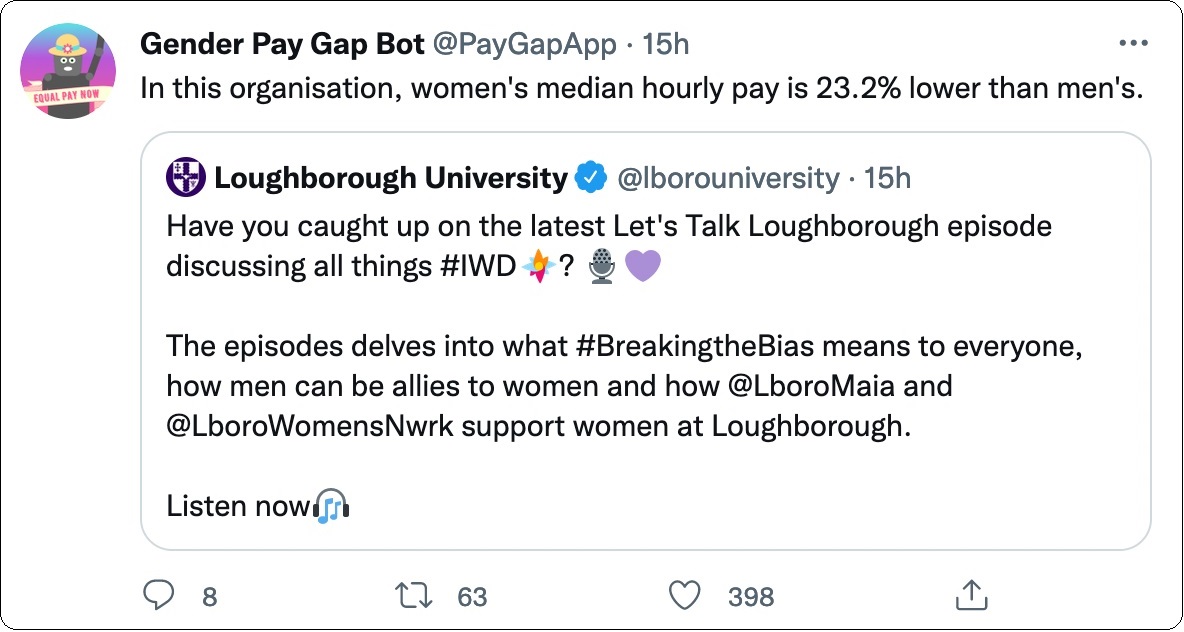A Twitter bot put organisations on notice on International Women’s Day, tweeting that organisation’s gender pay gap if they dared to say anything to mark the annual occasion.
Gender Pay Gap Bot, an automated tool that ‘listened’ on Twitter for certain keywords, was triggered if a tweet came from a company listed in the UK government gender pay gap database, a service we do not currently have in Australia.
The bot pushed out the difference in median hourly pay between men and women in a tweet that quoted the original IWD-related tweet.
The Gender Pay Gap Bot’s tweet simply says: “In this organisation, women's median hourly pay is 14.6 per cent lower than men’s” above the original tweet, for example.
The differences varied, from less than 1 per cent to much higher, and in a very few cases the women’s hourly pay was actually higher.
Created by copywriter Francesca Lawson and software developer Ali Fensome, the bot was able to utilise the database because in the UK, companies with over 250 employees must disclose their gender pay gap.
Lawson said she was pleased to have drawn awareness to the public availability of that information.
“If you have a gender pay gap, now is a good time to acknowledge it and then outline what you’re going to do to fix it,” she told The Drum.


How Australia ranks in the Gender Pay Gap
The Twitter tool brought attention to the Gender Pay Gap, an internationally established measure of women’s position in the economy relative to men’s.
In most cases it’s lower, the result of a whole host of social and economic factors that combine to reduce women’s earning capacity over their lifetime.
They include bias in hiring and pay decisions, women and men working in different industries and different jobs, with female-dominated industries and jobs attracting lower wages.
It also comes about because of women’s disproportionate share of unpaid caring and domestic work, a lack of workplace flexibility to accommodate caring and other responsibilities – especially in senior roles – and women’s greater time out of the workforce, impacting career progression and opportunities.
In Australia, the gender pay gap is 13.8 per cent (as of February 2022), with women earning around $255 per week less than men, according to the federal Workplace Gender Equality Agency.
Australia lacks a public database of gender pay gap
Australia ranked equal last in a scorecard on gender pay gap reporting across six countries, according to a report by the Global Institute for Women's Leadership (GIWL) at King's College London.
"After nearly four decades of gender equality reporting in Australia, many organisations have gender equality policies in place, but evidence suggests that many policies are ineffective," the report said.
To highlight the issue, Equal Pay Day is an annual event noting the continuing differences between men’s and women’s pay and why fairness and equality demand the closing of the gap.
For now, the Gender Pay Gap bot is only operating with UK data, but the pair have said they may add links to other sources if data become available.
Australia lacks a public register like the UK’s that publishes the gender pay gaps of individual organisations, something researchers from the ANU have identified as an important tool to improve the situation.
"Without action, we remain a country that is stuck in low power mode, while others outpace us,” said ANU researcher Dr Anna von Reibnitz.










